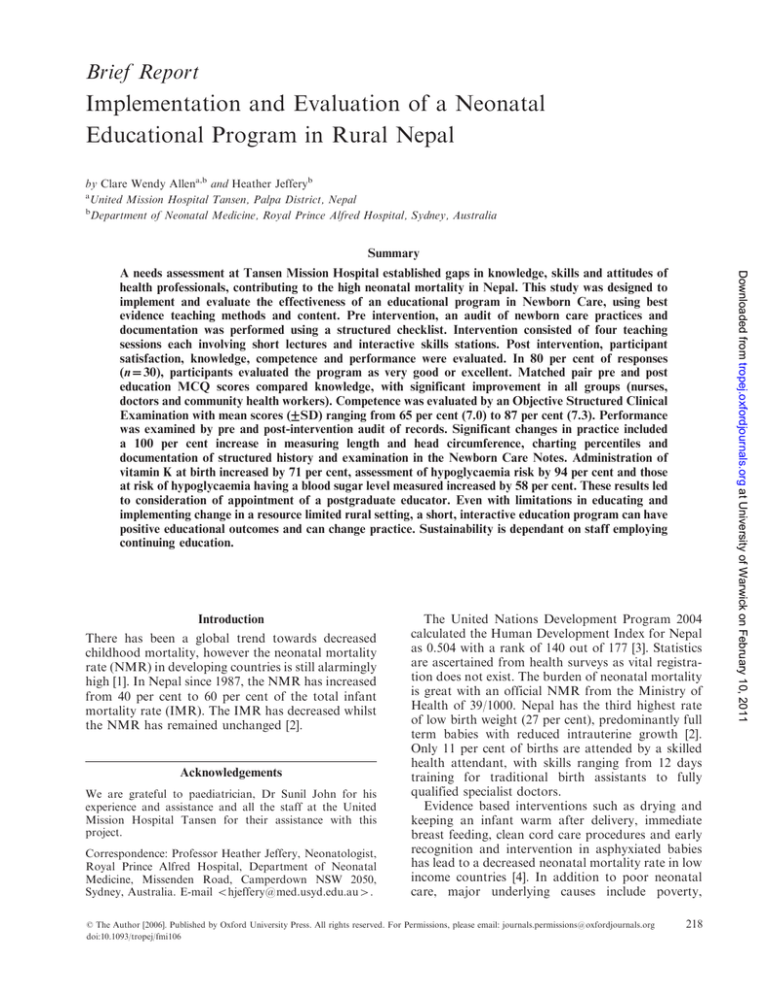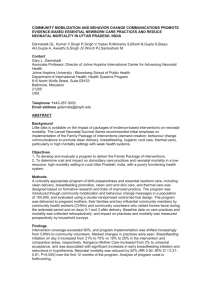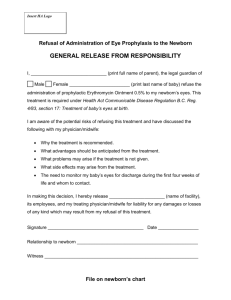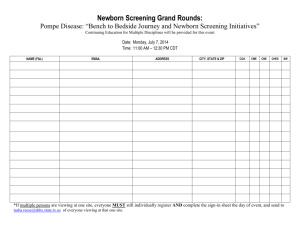
Brief Report
Implementation and Evaluation of a Neonatal
Educational Program in Rural Nepal
by Clare Wendy Allena,b and Heather Jefferyb
a
United Mission Hospital Tansen, Palpa District, Nepal
b
Department of Neonatal Medicine, Royal Prince Alfred Hospital, Sydney, Australia
Summary
Introduction
There has been a global trend towards decreased
childhood mortality, however the neonatal mortality
rate (NMR) in developing countries is still alarmingly
high [1]. In Nepal since 1987, the NMR has increased
from 40 per cent to 60 per cent of the total infant
mortality rate (IMR). The IMR has decreased whilst
the NMR has remained unchanged [2].
Acknowledgements
We are grateful to paediatrician, Dr Sunil John for his
experience and assistance and all the staff at the United
Mission Hospital Tansen for their assistance with this
project.
Correspondence: Professor Heather Jeffery, Neonatologist,
Royal Prince Alfred Hospital, Department of Neonatal
Medicine, Missenden Road, Camperdown NSW 2050,
Sydney, Australia. E-mail 5hjeffery@med.usyd.edu.au4.
The United Nations Development Program 2004
calculated the Human Development Index for Nepal
as 0.504 with a rank of 140 out of 177 [3]. Statistics
are ascertained from health surveys as vital registration does not exist. The burden of neonatal mortality
is great with an official NMR from the Ministry of
Health of 39/1000. Nepal has the third highest rate
of low birth weight (27 per cent), predominantly full
term babies with reduced intrauterine growth [2].
Only 11 per cent of births are attended by a skilled
health attendant, with skills ranging from 12 days
training for traditional birth assistants to fully
qualified specialist doctors.
Evidence based interventions such as drying and
keeping an infant warm after delivery, immediate
breast feeding, clean cord care procedures and early
recognition and intervention in asphyxiated babies
has lead to a decreased neonatal mortality rate in low
income countries [4]. In addition to poor neonatal
care, major underlying causes include poverty,
ß The Author [2006]. Published by Oxford University Press. All rights reserved. For Permissions, please email: journals.permissions@oxfordjournals.org
doi:10.1093/tropej/fmi106
218
Downloaded from tropej.oxfordjournals.org at University of Warwick on February 10, 2011
A needs assessment at Tansen Mission Hospital established gaps in knowledge, skills and attitudes of
health professionals, contributing to the high neonatal mortality in Nepal. This study was designed to
implement and evaluate the effectiveness of an educational program in Newborn Care, using best
evidence teaching methods and content. Pre intervention, an audit of newborn care practices and
documentation was performed using a structured checklist. Intervention consisted of four teaching
sessions each involving short lectures and interactive skills stations. Post intervention, participant
satisfaction, knowledge, competence and performance were evaluated. In 80 per cent of responses
(n^30), participants evaluated the program as very good or excellent. Matched pair pre and post
education MCQ scores compared knowledge, with significant improvement in all groups (nurses,
doctors and community health workers). Competence was evaluated by an Objective Structured Clinical
Examination with mean scores ([SD) ranging from 65 per cent (7.0) to 87 per cent (7.3). Performance
was examined by pre and post-intervention audit of records. Significant changes in practice included
a 100 per cent increase in measuring length and head circumference, charting percentiles and
documentation of structured history and examination in the Newborn Care Notes. Administration of
vitamin K at birth increased by 71 per cent, assessment of hypoglycaemia risk by 94 per cent and those
at risk of hypoglycaemia having a blood sugar level measured increased by 58 per cent. These results led
to consideration of appointment of a postgraduate educator. Even with limitations in educating and
implementing change in a resource limited rural setting, a short, interactive education program can have
positive educational outcomes and can change practice. Sustainability is dependant on staff employing
continuing education.
BRIEF REPORT
Methods
Pre intervention
Over a 6-week period prior to the educational
program, an audit of Newborn Care practices and
documentation was performed using a structured
Journal of Tropical Pediatrics
Vol. 52, No. 3
check list. Newborn data included details of
pregnancy, delivery, vital signs, gestational age and
percentiles.
Intervention
Four, 90 minute teaching sessions on Newborn Care
were given, involving short lectures and interactive
skills stations using the SCORPIO model adapted to
the setting of one teacher. Topics covered included
Newborn examination (A ‘‘Newborn Care Notes’’
proforma was introduced to encourage the staff
to document the examination, percentiles and note
important details in the record), Management of
low birth weight babies, Identification and management of common congenital malformations and
conditions, Hypoglycaemia, Bleeding and Jaundice.
Each teaching session had aims and objectives
derived from evidence based protocols sourced
from World Health Organisation guidelines [7]
and the RPA Department of Newborn Care
protocols [8].
Assessment and evaluation
The assessment and evaluation of the education
program consisted of four levels. These were
participant satisfaction, assessment of knowledge,
competence and performance.
Participant satisfaction with the education was
measured using a Likert scale and was collected
anonymously. Presentation technique, content, relevance to work, ease of understanding, opportunity
for interaction, tutor support and feedback were
evaluated. Opportunities were given to express how
the education sessions could be improved.
Knowledge was tested by pre and post-education
multiple choice questions (MCQs). A pool of
30 multiple choice questions relating to the learning
topics was generated. Fifteen questions were randomly selected for the pre-test and post test.
Competence in skills was examined by a post education Objective Structured Clinical Examination [9].
This consisted of 8 stations, with several parts to
some stations. The OSCE was marked according to
a structured score sheet. Performance was assessed
by a post education audit of Newborn Care practices
for 6 weeks using a structured checklist.
Statistical analysis
The random selection of MCQs was performed using
the Microsoft excel random number generator
program. Calculations of mean and standard deviation of scores were performed using Microsoft Excel.
The p values for comparing paired pre- and post-test
MCQ scores were calculated using the Wilcoxon
Signed Ranks Test, rather than a paired t test (low
numbers) and pre and post intervention administration of vitamin K was calculated using a 2 test using
SPSS with p50.05 considered significant.
219
Downloaded from tropej.oxfordjournals.org at University of Warwick on February 10, 2011
maternal malnutrition, poor maternal education,
poor infrastructure, difficult geography and political
instability. Nepal has a female adult literacy rate
of 26 per cent and 27 per cent of women have
a BMI518.5. One in seven women is under 145 cm
tall. Anaemia is present in 75 per cent of pregnant
mothers. The capacity of health systems to respond
to the needs of mothers and their newborns is
inadequate and access to health services is limited.
There is lack of trained staff in the primary health
care centres and district hospitals. This is worse in the
poorer rural hill-region villages where the burden of
neonatal death is the greatest.
Tansen lies in the Palpa district in rural Nepal.
The mission hospital is a referral centre for 5 million
people in the Western Region and is accessible by
road. The hospital has 131 beds, with 1200–1300
deliveries annually. A needs assessment established
gaps in educational knowledge and skills in Newborn
Care that contribute to morbidity and mortality in
this setting. Unsatisfactory practices included poor
standard of neonatal examination, poor understanding of the care of low birth weight babies, lack of
assessment of neonatal hypoglycaemia and lack of
routine administration of vitamin K. Satisfactory
practices with proven level 1 or level 2 evidence for
reducing mortality in newborns included newborn
resuscitation, thermal management, encouraging
exclusive breast feeding for 6 months and clean
delivery [4].
The aim of this study was to develop, implement
and evaluate an educational program in Newborn
Care, to empower the junior doctors, nurses and
community health workers to look after newborns
and hence decrease morbidity and mortality in the
hospital and the region. The education program’s
effectiveness was evaluated by auditing practices
before and after the educational program, participants undergoing pre and post education testing and
evaluation of participant satisfaction.
An evidence based model was used, with a fourtiered evaluation, based on positive health outcomes
in a National Perinatal Strategy in Macedonia, a low
income, central European country [5]. The reduction in neonatal mortality in Macedonia was largely
due to a targeted educational program, using a
validated method, SCORPIO, (Structured Clinically
Objective Referenced Problem-oriented, Integrated
and Organised) of small group interactive teaching
and learning [6].
BRIEF REPORT
87 per cent (7.3), nurses 65 per cent (7.0) and
community health nurses 70 per cent (21.4).
With regards to performance, all babies had
their weight, gestational age, vital signs, nature of
delivery and Apgar scores documented both preand post- the educational intervention. There were
however some significant changes post-education
in the areas of measurement and plotting of
percentiles, recognition and appropriate management of babies with hypoglycaemia and administration of vitamin K at birth. Significant changes
in practice in Newborn Care are documented in
Table 4.
Results
A total of 236 babies notes were audited during this
study. A summary of their epidemiology is seen in
Table 1. Participants (n ¼ 30) completed an evaluation scale and rated the program and all of its components as very good or excellent in over 80 per cent
of responses (Table 2). Pre- and post-test multiple
choice question scores were compared. Matched
pairs of pre- and post-test scores showed significant
improvement in all groups (p50.05) (Table 3).
The results of the Objective Structured Clinical
Examination (n ¼ 22) showed mean score (SD)
was 76 per cent (14.7) overall, for junior doctors
Sex Male %
Female %
GA 537 weeks %
Ave weight (g)
Low birth weight (52500 g) %
LBW with GA 537 weeks %
Post natal deaths (0–7days)
Number of stillbirths
Average length
Average head circumference
Rate of LSCS
Rate of vacuum delivery
Pre intervention
(n ¼ 115)
Post intervention
(n ¼ 121)
52
48
19
2757
30.4
48.5
0
5
Not measured
Not measured
18.2%*
10.4%
53
47
13
2762
24.8
38.7
2
3
48.6 cm
33.7 cm
8.3%
3.3%
*Annual Caesarian section rate average (1999–2003) – 14.2%.
Table 2
Summary of participant evaluation responses using Likert Scale (n ¼ 30)
Very good or
excellent (%)
Average (%)
Poor or below
average (%)
97
93
80
87
87
100
3
7
20
13
13
0
0
0
0
0
0
0
Presentation technique
Content
Relevance to work
Ease of understanding
Opportunity for interaction
Tutor support and feedback
Table 3
Matched pair results of pre and post test multiple choice questions
Pre test mean score %
(SD)
Hospital nurses (n¼7)
Junior doctors (n¼10)
Community health nurses (n¼6)
Total (n¼23)
220
63
67
47
60
(8.5)
(14.7)
(6.0)
(13.7)
Post test mean score %
(SD)
84
83
77
81
(10.1)
(8.5)
(9.2)
(9.3)
Average improvement %
p value
21
17
30
21
0.03
0.01
0.02
50.001
Journal of Tropical Pediatrics
Vol. 52, No. 3
Downloaded from tropej.oxfordjournals.org at University of Warwick on February 10, 2011
Table 1
Descriptive epidemiology of consecutive in-hospital births
BRIEF REPORT
Table 4
Significant changes in practice of newborn care
Parameter measured
Pre intervention % (n ¼ 115)
Post intervention % (n ¼ 120)
Nil
Nil
Nil
Nil
24.5
0.9
0.9
100
100
100
100
95.8
95.0
59.1
Newborn care notes (history, exam etc)
Length measured
Head circumference measured
Percentiles charted
Vitamin K given at birth
Hypoglycaemia risk assessed
BSL measured where at risk of hypoglycaemia
Journal of Tropical Pediatrics
Vol. 52, No. 3
Specific health outcomes were not measured in this
study as follow up of healthy babies was not feasible
due to lack of perceived need, financial and geographical constraints. Recent data however using this
approach in Macedonia has translated to a decrease
in early neonatal mortality rate by 36 per cent [5].
The dramatic increase in the number of newborns
receiving vitamin K at birth was encouraging. There
is no data on the incidence of Haemorrhagic Disease
of the Newborn in Nepal. However, a recent study
was performed in the Hanoi province in Vietnam
where bleeding due to vitamin K deficiency is a
major health problem, with a reported incidence of
100/100 000 births and a high mortality [13]. This
reported data indicate that routine vitamin K
prophylaxis would significantly reduce infant
morbidity and mortality.
Performance was improved as a result of the
education program. Assessing babies for hypoglycaemia increased by over ninety percent, however
of the babies identified as at risk of hypoglycaemia
only 59 per cent of them had their blood sugar level
measured. Due to financial constraints, staff were
reluctant to test clinically well babies even if they
were identified as being at risk of hypoglycaemia.
This lack of resources affects the sustainability of the
improvements that are gained by increased awareness
of problems.
This education program proved successful in
increasing both knowledge and competence in the
participants. The improvement in knowledge was
seen in an average of 20 per cent improvement in
MCQ scores. Facilitators of change included the
support of senior medical and administrative staff
and enthusiastic response by staff to learn ways to
improve newborn care, as evidenced by the positive
evaluation of the teaching program and requests for
further teaching sessions.
The main barrier to change was a distinct lack
of perception of the disease burden in the community. Without a perception of a problem, there is little
incentive to adapt to changes. This barrier could be
targeted by training doctors and nurses in a setting
where there is evidence-based neonatal care focussed
on outcomes.
221
Downloaded from tropej.oxfordjournals.org at University of Warwick on February 10, 2011
Discussion
For countries in transition, the decrease in less than
five years childhood mortality is associated with an
increase in the proportion due to neonatal deaths.
It is estimated that 38 per cent of all under 5 years
deaths occur in the first month of life. Decreasing
the under 5 years mortality by 2/3 by 2015 is the
fourth Millennium Development Goal [10]. This has
recently been targeted by the WHO, with a greater
educational focus and publication of a short text
on Newborn Care [7]. Save the Children have
published a more practical text with the same
approach [11].
Evidence of effective community-based interventions in low income countries have been summarised
recently. This revealed a paucity of community-based
data for many interventions being considered
for neonatal health programs and highlighted the
need for further research and evaluation of these
interventions [12].
There are enormous needs for improvement in
newborn care in low income countries where the
neonatal mortality is so unacceptably high. This
study was conducted in a hospital situation, which
is not representative of the general population of
mothers and newborns in Nepal. Nevertheless, at
one point in the health system we have demonstrated
that gains can be made by an evidence-based
educational approach. Education directed at this
secondary/tertiary level hospital is relevant to
district hospitals and community and village referral
patterns, there being little point in referral
unless outcomes are better at this point in the
health system.
This paper reports that even in resource limited
areas of the world, interactive, small group, low cost,
evidence-based education programs in low income
countries over short periods of time can improve
neonatal care. Better education can translate to
behavioural change and improved clinical practice.
The results of this observational study provide the
impetus to design large randomised trials with a
greater variety of outcomes and thus afford greater
certainty for wider implementation if supported by
higher levels of evidence.
BRIEF REPORT
References
1. Lawn JE, Cousens S, Bhutta ZA, et al. Why are
4 million newborn babies dying each year? Lancet
2004;364:399–401.
2. Save The Children USA. State of the world’s newborns:
Nepal. Saving Newborn Lives. July 2002; pp. 8–13.
3. United Nations Development Report. Human
Development Report Nepal, 2004, New York: Oxford
University Press.
4. Jones G, Steketee R, Black R, et al. How many
child deaths can we prevent this year? Lancet 2003;
362:65–71.
222
5. Jeffery HE, Kocova M, Tozija F, et al. The impact of
evidence-based education on a perinatal capacity
building initiative in Macedonia. Med Educ 2004;
38:435–47.
6. Hill DA. SCORPIO: A strategy for teaching
and learning in the PBL clerkship. Med Teach 1997;
19:24–8.
7. World Health Organisation. Integrated management
of pregnancy and childbirth. Managing newborn
problems: a guide for doctors, nurses and midwives.
WHO 2003.
8. Royal Prince Alfred Hospital, Department of
Newborn Care. Medical Protocols at Royal Prince
Alfred Hospital Sydney. http://www.cs.nsw.gov.au/rpa/
neonatal/ (August 2005, date last accessed).
9. Harden RM, Gleeson FA. Assessment of clinical
competence using an objective structured clinical
examination. Med Educ 1979;13:41–54.
10. Lawn JE, Cousens S, Zupan J. 4 million neonatal
deaths: When? Where? Why? Lancet 2005;365:
891–900.
11. Parlato R, Darmstadt G, Tinker A. Saving Newborn
Lives Tools for Newborn Health. Qualitative Research
to Improve Newborn Care Practices. Save the Children
USA, 2004.
12. Bhutta ZA, Darmstadt GL, Hasan BS, et al.
Community-Based Interventions for Improving
Perinatal and Neonatal Health Outcomes in
Developing Countries: A review of the Evidence.
Pediatrics 2005;115(2):519–617.
13. Danielsson N, Hoa DP, Thang NV, et al. Intracranial
haemorrhage due to late onset vitamin K deficiency
bleeding in Hanoi province, Vietnam. Arch. Dis Child
Fetal Neonatal Ed 2004;89:F546–F550.
Journal of Tropical Pediatrics
Vol. 52, No. 3
Downloaded from tropej.oxfordjournals.org at University of Warwick on February 10, 2011
Limitations in undertaking this study included
limited time, technology and resources. Communication was difficult as trained translators were not
available. The population of babies that were
included in the study were not representative of the
community as they were selected by the fact that they
were born in a hospital. However community nurses
were included and most responsive to the program
as evidenced by the results.
The sustainability of a project such as this is
essential to its positive effect. Sustainability of these
changes is dependant on ongoing education and
assessment of competence and performance. This is
envisaged by employing a professional nurse educator to continue education, encourage implementation
of evidence based protocols and audit newborn
practices. Future work is proposed to reassess
the impact of the educational intervention after
12 months.






